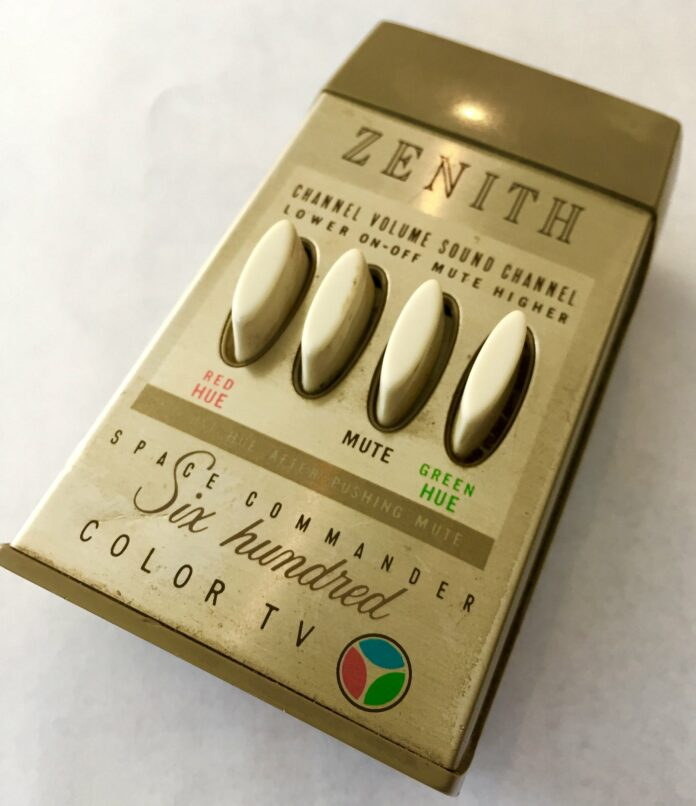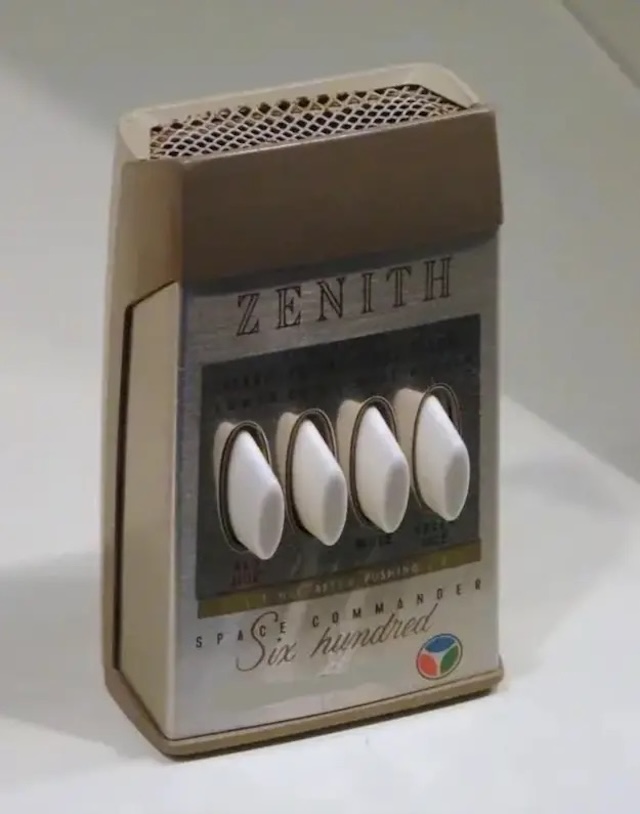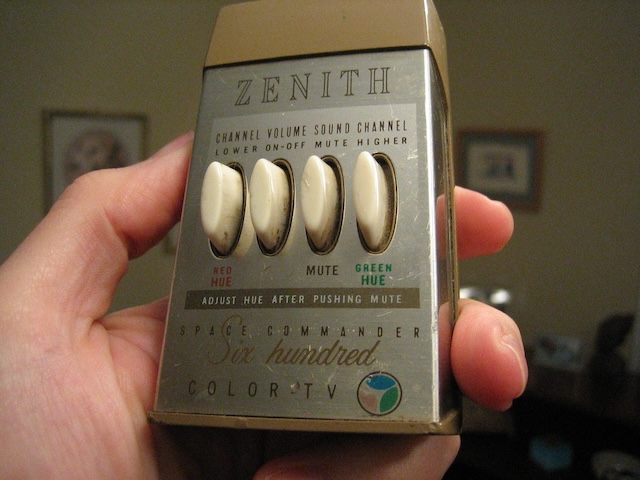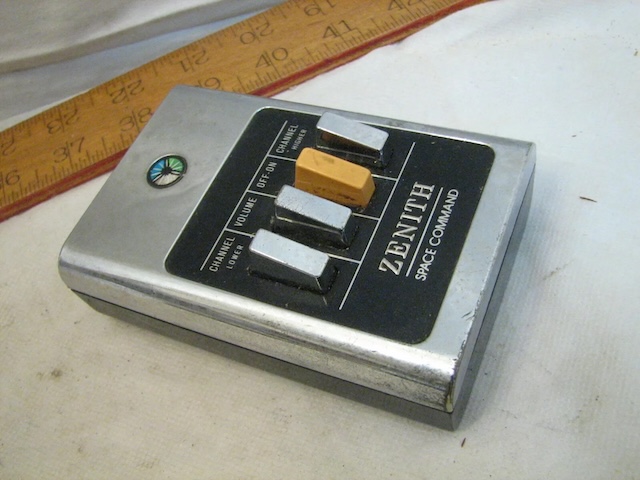Before the era of voice-activated assistants and touchscreens, simple innovations were groundbreaking. One such device was the Vintage Zenith Space Commander Six Hundred TV Remote Control, a 1950s marvel that revolutionized the way people interacted with their televisions. It was not just a gadget; it represented a significant leap in convenience and user control in the early days of home entertainment.

A Peek into the Past: The Birth of Remote TV Control
The 1950s marked a time of rapid technological growth, with televisions becoming a common feature in middle-class homes across America. While the TV itself was an incredible invention, there was one notable inconvenience—manually turning the dial to change channels or adjust the volume. The process meant having to get up from your cozy spot on the couch, which disrupted the viewing experience.
The need for a better solution led to the creation of the Vintage Zenith Space Commander Six Hundred. Zenith Electronics, led by Dr. Robert Adler, introduced this groundbreaking remote in 1956, transforming TV watching into a more relaxed experience. It was a moment that signified a shift in the way people engaged with technology, paving the way for a more convenient, user-friendly entertainment landscape.
The Revolutionary Design of the Zenith Space Commander
The design of the Vintage Zenith Space Commander Six Hundred TV Remote was both simple and innovative. Unlike today’s remotes that rely on infrared technology, the Space Commander operated using ultrasonic sound frequencies—a radical concept at the time. It had a distinctive look, with four buttons that performed basic functions: On/Off, Volume Up, Volume Down, and Channel Change.
The remote had no batteries. Instead, pressing a button triggered a small hammer to strike a metal rod inside the device, producing ultrasonic sounds. Each button emitted a unique sound frequency that corresponded to a specific command, which the TV’s receiver could pick up. It was an elegant engineering solution that allowed viewers to control their televisions wirelessly—an impressive feat for the mid-20th century.
How the Space Commander Became a Must-Have Gadget
The arrival of the Vintage Zenith Space Commander turned out to be a game-changer. Suddenly, viewers no longer needed to leave their seats to switch channels, adjust the volume, or turn the TV off. This added level of convenience made it a must-have household accessory, and it quickly became a popular feature of TV sets across America.

A close-up view of the classic Vintage Zenith Space Commander Six Hundred TV remote control, with its iconic four buttons used for channel, volume, mute, and tint adjustment
The remote’s robust design also contributed to its appeal. Unlike modern remotes, which can be easily misplaced or damaged, the Space Commander was sturdy, durable, and reliable. Its solid build ensured that it could withstand frequent use, making it a long-lasting addition to the household.
The Science Behind Ultrasonic Remote Technology
The science of the Space Commander’s ultrasonic frequencies was both fascinating and effective. Each press of a button emitted a high-pitched sound wave that was inaudible to the human ear but easily detected by the TV’s receiver. This sound-based communication was a novel approach that distinguished the Space Commander from earlier remote designs.
However, this innovative mechanism was not without its quirks. Occasionally, everyday high-pitched sounds—like jangling keys or clinking glassware—could inadvertently trigger the TV to change channels or adjust volume. While this unintended side effect was sometimes amusing, it was also a reminder of the limitations of early remote technology.

Holding the Vintage Zenith Space Commander Six Hundred TV remote, a glimpse into mid-century television convenience, showcasing the large buttons designed for easy control
The Social Impact of Remote Control Technology
The introduction of the Vintage Zenith Space Commander Six Hundred TV Remote Control was more than just a technological advancement; it marked a shift in TV culture. The ability to change channels with the press of a button encouraged viewers to “channel surf,” leading to a new kind of interaction with television programming. People could quickly switch channels during commercials or browse options without committing to one program.
Within households, the remote control also became a coveted device, sparking playful debates over who would hold it. It wasn’t just a tool—it was a symbol of control over entertainment, cementing TV’s role as the centerpiece of American living rooms.
Historical Significance: Pioneering the Future of Remotes
Zenith’s Space Commander wasn’t the world’s first TV remote, but it was the first truly successful wireless model. Its predecessor, the “Lazy Bones,” was wired and didn’t achieve the same popularity due to the inconvenience of the cables. The Space Commander, with its cordless design, offered a sleek and functional solution that set the standard for remote technology.
The impact of the Space Commander extended beyond the 1950s. The ultrasonic remote remained the standard until the 1980s when infrared technology eventually replaced it. Yet, the Vintage Zenith Space Commander Six Hundred remains an enduring symbol of innovation, representing the early days of user-friendly home entertainment.
Fun Facts About the Vintage Zenith Space Commander
- Accidental Activation: The remote’s ultrasonic sound waves were so sensitive that other ultrasonic sounds, like clinking keys or glass, could occasionally trigger the TV, causing unexpected channel changes.
- Basic Controls: With only four buttons—On/Off, Volume Up, Volume Down, and Channel Change—the Space Commander was simple yet revolutionary, offering newfound control for TV viewers.
- Collectible Item: Today, the Vintage Zenith Space Commander Six Hundred is a sought-after collector’s item. It holds value among tech enthusiasts and vintage collectors, symbolizing the beginnings of remote control technology.
- Sturdy Build: The remote’s heavy, durable construction set it apart from today’s lightweight designs. Made to last, it was a reliable companion to the bulky TV sets of the time.

Another model from the same line, the Zenith Space Command, which features distinctively colored buttons to further enhance user interaction
The Legacy of Remote Controls
The Vintage Zenith Space Commander set the stage for the modern remotes we use today. It was the first step towards making home entertainment more accessible and convenient. Without this early innovation, the evolution of remote controls might have taken longer, delaying the interactive TV experience we now take for granted.
Although it seems quaint compared to today’s multi-functional remotes, the Space Commander was groundbreaking in its era. It showcased the possibilities of wireless technology, demonstrating how simple innovations could reshape everyday life.
Conclusion: A Game-Changing Device in Home Entertainment
The Vintage Zenith Space Commander Six Hundred TV Remote Control wasn’t just a gadget—it was a cultural milestone that transformed the way we interacted with our televisions. It made TV watching more convenient, encouraged channel surfing, and became a staple of the American living room.
Today, the Space Commander serves as a nostalgic reminder of a time when just four buttons were all it took to revolutionize home entertainment. It remains a treasured piece of history that highlights the ingenuity of mid-20th-century technology, symbolizing the beginning of a new era of user-friendly devices that set the stage for our modern, connected world.


